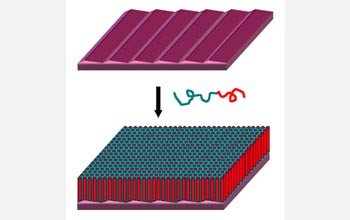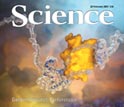|

Press Release 09-028
Revolutionary Method Generates New Template for Microelectronics

Copolymer may enable 10 times more computer memory
February 20, 2009
Researchers say a newly tested method for producing super dense, defect-free, thin polymer films is the fastest, most efficient method ever achieved and it may dramatically improve microelectronic storage capabilities such as those in computer memory sticks. In the February 20 issue of the journal Science, researchers at the University of Massachusetts Amherst and their colleagues at the University of California Berkeley, report how they designed a new way to guide the self-assembly of the material used to store computer memory, layered block copolymers, and generate up to 10 times more storage space than similarly sized copolymers. The researchers say they developed a defect-free method that can generate more than 10-terabit-per-square-inch copolymer where other efforts achieved at most one terabit per square inch. A terabit is an information storage unit equal to one trillion bits. "We can generate nearly perfect arrays over macroscopic surfaces where the density is over 15 times higher than anything achieved before," said Thomas Russell director of the UMass Materials Research Science and Engineering Center. He co-led the research with Ting Xu, a member of the Department of Materials Science and Engineering at Berkeley. "We applied a simple concept to solve several problems at once, and it really worked out," Russell said. The concept involved stacking atoms more closely together than previously thought possible to produce the highest density copolymer ever achieved, one capable of storing more information than previous copolymers. Researchers used surface ridges of a base crystal to guide the assembly very much like using the corrugations in cardboard to direct how closely marbles can be packed together. For the copolymer's base layer, the researchers used commercially-available sapphire wafers, which start out flat. After heating them from 1300 to 1500 degrees Celsius for 24 hours, the wafer's surface reorganized into a sawtooth topography with an inherent orientation. A thin copolymer film layer then was applied causing the underlying sawtooth corrugations to guide the film's self-assembly in a highly-ordered way to form an ultra-dense hexagonal, or honeycomb, crystalline lattice. Additionally, by varying the annealing temperature, the scientists were able to change the angle and height of the sawteeth and the depth of the troughs between their peaks. The result enabled researchers to produce more densely packed troughs, which is where computer memory is stored. The work was supported by the National Science Foundation and the Department of Energy's Office of Basic Energy Science. "I expect this new method of producing highly ordered macroscopic arrays of nanoscopic elements will revolutionize the microelectronic and storage industries and perhaps others," said Russell. He points out most previous efforts to create a well-ordered base material onto which electronic information is stored topped out at 15 nanometers for the smallest achievable pattern size. But "we've shattered that barrier and I think we can go farther," Russell said. "This research by the teams at UMass Amerherst and Berkeley represents a significant breakthrough in the use of polymer self-assembly to create a high density of addressable locations in a thin film," said NSF program manager William J. Brittain. "Most significantly, the simple crystalline lattice used as the template may serve as a revolutionary step for a new generation of computer memory."
-NSF-

Media Contacts
Bobbie Mixon, NSF (703) 292-8070 bmixon@nsf.gov
Program Contacts
William J. Brittain, NSF (703) 292-5039 wbrittai@nsf.gov
Principal Investigators
Thomas P. Russell, University of Massachusetts Amherst (413) 545-2680 russell@mail.pse.umass.edu

The National Science Foundation (NSF) is an independent federal agency that supports fundamental research and education across all fields of science and engineering. In fiscal year (FY) 2009, its budget is $9.5 billion, which includes $3.0 billion provided through the American Recovery and Reinvestment Act. NSF funds reach all 50 states through grants to over 1,900 universities and institutions. Each year, NSF receives about 44,400 competitive requests for funding, and makes over 11,500 new funding awards. NSF also awards over $400 million in professional and service contracts yearly.
 Get News Updates by Email Get News Updates by Email
Useful NSF Web Sites:
NSF Home Page: http://www.nsf.gov
NSF News: http://www.nsf.gov/news/
For the News Media: http://www.nsf.gov/news/newsroom.jsp
Science and Engineering Statistics: http://www.nsf.gov/statistics/
Awards Searches: http://www.nsf.gov/awardsearch/
| 


